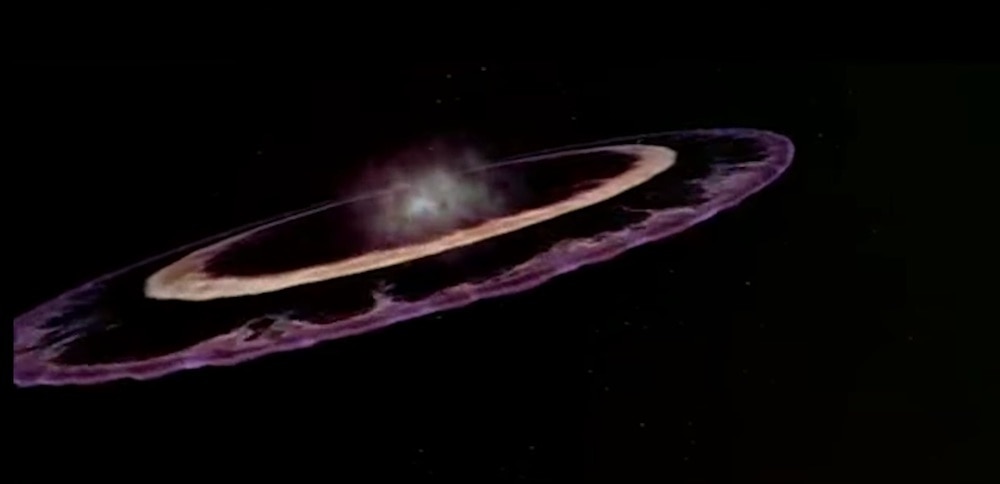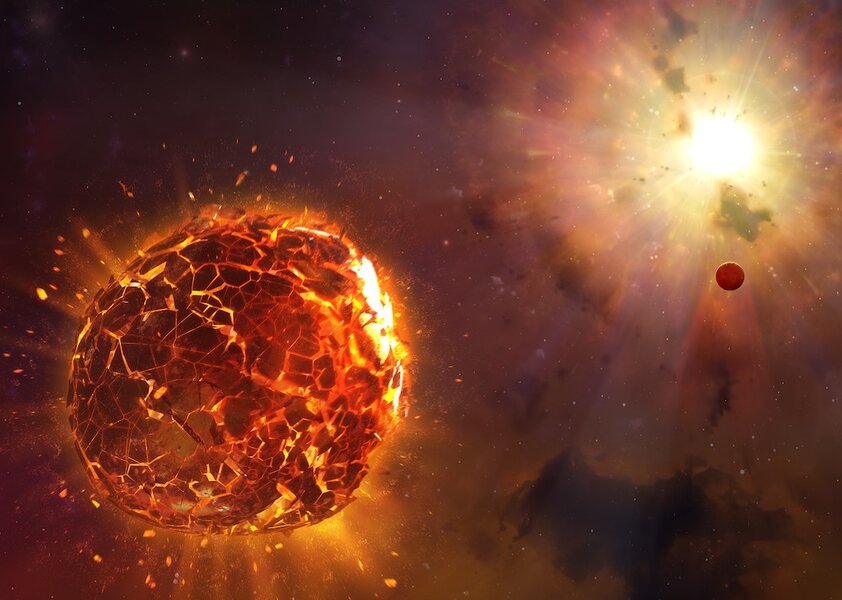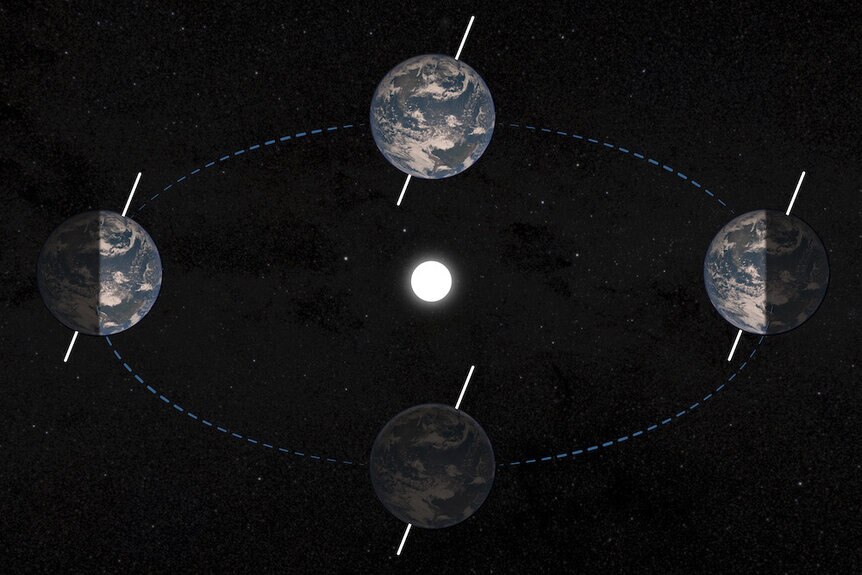Create a free profile to get unlimited access to exclusive videos, sweepstakes, and more!
If the Moon Disappeared, What Would It Mean For Earth?
It's not a good idea, in any event.

In 2293, while returning home after a successful mission cataloging gaseous planetary anomalies in the Beta Quadrant, the USS Excelsior, under the command of Captain Hikaru Sulu was struck by a subspace shock wave. Initial investigation revealed the shock wave resulted from the destruction of Praxis; a Klingon moon utilized for energy production.
With only fragments of the moon remaining, the destruction of Praxis threatened Klingon, eating away at their ozone layer leading to the total loss of oxygen over the ensuing 50 years. Surely, the destruction of a moon is a violent and serious thing — enough that it forced an end to decades-long hostilities and a tenuous peace between two warring races. But could a moon really be destroyed? And if so, would it lead to the imminent demise of the parent planet? With Star Trek VI: The Undiscovered Country turning 30 this week, it seems like a good time to ponder these important questions.
Blowing up the moon
Since we don't have direct observations of Praxis, it being a fictional moon and all, we'll use Earth's moon as a proxy. In order to blow up the Moon (or a planet) you need enough energy to overcome its binding energy, that being the amount of energy holding the whole thing together. The more massive the object, the more binding energy it has. And while the Moon is a relatively small object compared to something like the gas giants, and even to Earth, it still has a lot of binding energy. Something like 120 octillion joules — that's a 12 with 28 zeroes behind it.
But that's a little difficult to visualize so let's try to bring it home. A standard stick of dynamite, measuring about 8 inches long, carries one megajoule of explosive energy inside it. That's a 1 with 6 zeroes behind it. It's a decent amount, certainly enough to be dangerous, but it's laughably small if you're in the moon-blowing-up-business.
If dynamite is all you have at your disposal, then you're going to need a whole lot of it. The math is pretty simple, dividing that big number up above for the Moon's binding energy by ten involves just taking away a zero. Dividing it by a megajoule, is the same as dividing by a million, so you take away six zeros to get the total number of sticks of dynamite we need to blow up the Moon.
We'd need 120,000,000,000,000,000,000,000 eight-inch sticks of dynamite. Laid out in a line, that much dynamite would stretch beyond the edge of our solar system. It's a lot. Not very feasible. Let's try something more powerful.
The Tsar bomb, the most powerful atomic bomb every deployed had a yield of 50 megatons. Though, that was dialed down for the test from its capacity of 100 megatons. Let's use the larger number, just for fun.
A 100-megaton bomb carries 4.184 times ten to the 17th power joules of cosmic explosion power in it. If we divide that into the binding energy of the Moon we'd need — hold on while I break out the calculator — about 287 billion of those bombs. If we outfitted everyone on Earth with a cool spaceship and sent an armada of the entire human population to the Moon carrying bombs, we'd each have to have a compliment of 36 100-megaton bombs to get the job done, and that's assuming none of that energy is lost to space and we can cram all of it into the Moon.
Suffice it to say, whatever the Klingons were doing on Praxis it was incredibly powerful and they're all lucky to have lived through it at all. Supposing we can actually blow up the Moon, whether accidentally or on purpose, would it spell an imminent demise for humanity?
What would happen if the moon disappeared?
The most immediate consequence of destroying the Moon would be a much darker night sky. The Moon is the largest and most-reflective object in our sky, outside of the Sun of course. Losing it would make the rest of the sky comparatively brighter, which might be a nice side effect for ground-based deep-sky astronomers. We'll chalk that one up to silver linings.
Aside from missing it in the night sky, there are two main things which would change if the Moon no longer existed. First are the tides.
How does the moon affect the tides?
That we have tides at all, the shifting of bodies of water of time, is a consequence of gravitational relationships between the Earth and Moon, and to a lesser degree the Sun. As the Earth rotates and as the Moon orbits the Earth, it tugs on the oceans pulling them this way and that. If it were gone tomorrow, the tides wouldn't totally vanish, but they'd be much less impressive.
The tides we enjoy today get about two-thirds of their movement from the Moon. On a moonless Earth, the oceans would still move beneath the sway of the Sun's gravity, but it would be much smaller. As a result, coastal regions and environments might be pretty drastically changed. The effect would probably be felt further out to sea as well, as the currents change in response to the diminished tides.
It's difficult to know exactly what level of impact this would have on global ecology, but it probably wouldn't be the best. Still, it's not a world-ending scenario. In all likelihood we would adjust and be okay.
The other major impact the Moon has on the Earth relates to its tilt. The Earth sits at a pretty steady tilt of 23.5 degrees and that's largely because the Moon acts as a sort of walking stick for us to lean on. Because our tilt is steady, we enjoy moderately stable seasons year over year and the polar regions remain comparatively cold.
Without the Moon's influence, the Earth's tilt would shift much more dramatically. Basically, because the Moon is moderately large and close, it's the most apparent gravitational companion we have (again, aside from the Sun). But without it, we'd be at the mercy of gravitational pushes and pulls from the other planets in our solar system. Over time, the tilt of the Earth could get all out of whack and those snowy winters and warm summers we've come to rely on, would be out the proverbial window.
Something like that, however, would take a long time. It's probably not something we'd notice along human timescales. All told, if the Moon was destroyed it would be a big emotional bummer, but it wouldn't be life-destroying
Let us be clear though, destroying the Moon is a monumentally bad idea and we don't endorse it, just in case any supervillains or extraterrestrial forces are reading this. We like our Moon just the way it is.
Originally published Dec 8, 2021.




























